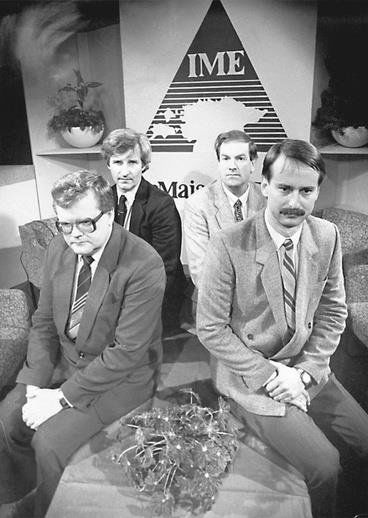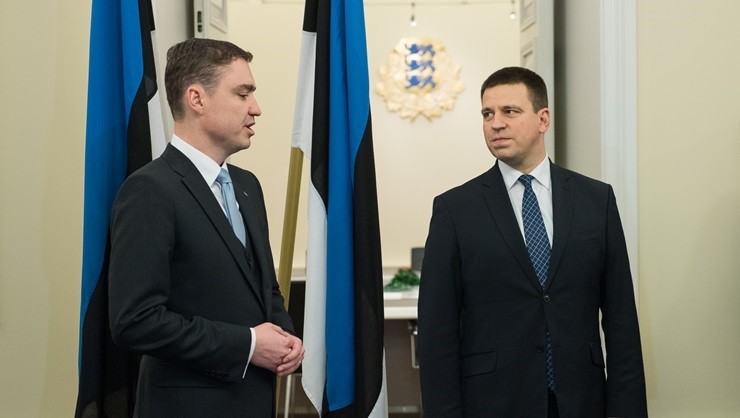Estonia’s “pro-NATO” government was not toppled in favour of a “pro-Russian” one. The forces guiding former prime minister Taavi Rõivas and his successor, Jüri Ratas, are very local and are rooted in differing concepts about what Estonian independence is actually supposed to mean, Justin Petrone writes.
The previous Estonian coalition government of the Reform Party, the Social Democrats and Pro Patria and Res Publica Union (IRL) split in early November, after the Social Democrats and IRL announced that they had asked prime minister Taavi Rõivas to resign. Rõivas lost the following vote of confidence on 9 November and the new coalition talks started. On 19 November, the Centre Party, the Social Democrats and IRL agreed on the conditions of the new coalition under Jüri Ratas, whose cabinet was sworn in on 23 November.
I couldn’t look at the images of the outgoing prime minister, Taavi Rõivas, and the incoming one, Jüri Ratas, without a certain chill. Both men are within a year of me in age, and no, I do not look at them with any kind of jealousy or contempt over what I have failed to achieve in life – “How come I’m not the prime minister?” – but rather sincere compassion, empathy for seeing both men for who they are – mere lieutenants entrusted with carrying out the visions of their superior officers.
 To understand the predicament of Rõivas, age 37, or Ratas, age 38, is to go back to the very concept of post-war Estonian independence. Here I am haunted by the image from 1987’s IME project, a series of economic proposals drafted concerning an imagined self-governing Estonia. The two men seated in front of that iconic IME photo are, to the left, the Centre Party patriarch, Edgar Savisaar, and to the right, the Reform Party soul instigator, Siim Kallas. Both men, no doubt, sought to do in 1987 what their grandfathers and great grandfathers had sought to do in 1918, to separate Estonia from the “rotten foundations” of the Russian Empire.
To understand the predicament of Rõivas, age 37, or Ratas, age 38, is to go back to the very concept of post-war Estonian independence. Here I am haunted by the image from 1987’s IME project, a series of economic proposals drafted concerning an imagined self-governing Estonia. The two men seated in front of that iconic IME photo are, to the left, the Centre Party patriarch, Edgar Savisaar, and to the right, the Reform Party soul instigator, Siim Kallas. Both men, no doubt, sought to do in 1987 what their grandfathers and great grandfathers had sought to do in 1918, to separate Estonia from the “rotten foundations” of the Russian Empire.
Estonia was better off alone, pursuing its own destiny. That has always been the great ideal.
Two pathways
At that time, there were two competing but not exclusive visions of the path this restored state could take. Some envisioned Estonia as a sort of Baltic Singapore, a multicultural free market-floating materialistic island paradise guided by the all-knowing and all-seeing invisible hand of unfettered commerce. Estonia in 1987 was quite poor and lagging its wealthy Nordic neighbours. It needed to catch up as quickly as possible. This vision, I think, is at the root of so much of what we associate with the Estonia of 2016 – the e-state, flat taxation, the talk of a Nordic Silicon Valley – with the Reform Party serving the same permanent role as Singapore’s People’s Action Party, which has remained the main force in that island country since its independence in 1959.
It was this role that Taavi Rõivas, the not-necessarily-lucky, designated heir of Andrus Ansip and Siim Kallas, was entrusted in carrying out, a historical weight that was thrust upon his shoulders.
The other perspective of a self-governing Estonia that emerged in 1987, was one roughly analogous to its neighbour Finland, a country that in return for agreeing to a sort of geopolitical invisibility – how many alarmist articles have been raised in recent months about an inevitable invasion of Helsinki? – was able to separate itself from rule by Moscow and achieve its own kind of domestic superiority at all levels. Considering the demographic situation in Estonia, which hosted hundreds of thousands of Soviet-era migrants, the “Finnish Way” seemed like an alternative that could help achieve the twin goals of domestic prosperity and independence, with Savisaar imagining himself as a sort of deal-making Urho Kekkonen, who could keep the Russians happy but away at arm’s length.
Focus on progressive taxation and social integration
The Centre Party and Social Democrats have come to embody this vision of Estonia, with their focus on progressive taxation and social integration. There is nothing necessarily “pro-Russian” about such a vision. It has at its core an idea of what an independent state could be that was hatched when Ratas and Rõivas were in grade school.
This is the vision that our untried new prime minister has inherited from his predecessors. It is now he who must work with his colleagues to bring more of this vision to life.
With this in mind, I can only feel confusion and disappointment about the media coverage of the recent change in government. Estonia’s “pro-NATO” government was not toppled in favour of a “pro-Russian” one. This is not some kind of Kremlin-backed putsch. Taavi Rõivas is not Washington’s point man on the front lines of the New Cold War, and Jüri Ratas is not some Kremlin stooge manipulated into place to carry out Moscow’s bidding.
The newly sworn-in government is not the equivalent to the cadre of depressed poets, historians and marginal left-wing politicians that were handpicked at the Soviet embassy to make the 1940 occupation and annexation of the country look legitimate. The forces guiding both men are very local and are rooted in differing concepts about what Estonian independence is actually supposed to mean.
I
The opinions in this article are those of the author. Cover: Taavi Rõivas handing over his job to Jüri Ratas (photo by Siim Lõvi/courtesy of ERR)

